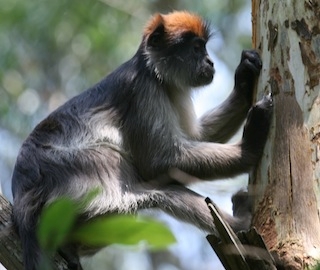Soy is now everywhere in the American diet. Tofu has become a more mainstream ingredient, soy milk crowds dairy cases, and soy fillers and additives can be found in processed foods from soups to meat and vegi-burgers to flavorings like cheese powders. The ubiquitous bean’s high levels of estrogen-mimicking compounds, called phytoestrogens, have long been a topic of scientific study and the nation’s ongoing conversation about nutrition and health. Does eating soy impact our sexual development? Harm women’s reproductive health? Minimize the symptoms of menopause? In a confusing matrix of news reports over the past decade, it’s been reported to both encourage some cancers and protect against others.

“Despite great interest in the effects of phytoestrogens on humans and livestock, very little is known about how often estrogenic plants are consumed by our closest-living relatives, so I decided to begin screening the important plant foods of various wild primate species for estrogenic activity,” said Michael Wasserman, a postdoctoral scholar in the Department of Anthropology at McGill University and lead author of the study, who conducted the research while completing his Ph.D. in UC Berkeley’s Department of Environmental Science, Policy, and Management.
Working in lab of Dale Leitman, an adjunct professor in UC Berkeley’s Department of Nutritional Sciences and Toxicology, Wasserman measured the presence of phytoestrogens in the diets of two leaf-eating primate species from Uganda and found that both species routinely consumed estrogenic plants as part of the staple foods in their diets. The red colobus monkey of Kibale National Park consumed more than 10 percent of its diet in estrogenic plants, and in mountain gorilla of Bwindi Impenetrable National Park, studied by his co-author Jessica Rothman, an assistant professor of primate ecology at Hunter College, estrogenic plants comprised nearly 9 percent of the animals’ total diet.
Wasserman is now looking into how these plants affect the red colobus’s endocrine system, which, like ours, regulates many physiological processes and behaviors. He is also measuring the presence of phytoestrogens in the diets of fruit-eating primates, like the chimpanzee, which should yield more information about the relationship between these animals and plants.
As his findings grow, Wasserman hopes the research will shed light on how long humans have been eating estrogenic plant foods over our evolutionary history.
“Throughout most of human history we have lived as hunter-gatherers, consuming large amounts of wild plant foods, especially fruits, and our biology has changed little since these pre-agricultural times,” he said.
By studying chimpanzees, gorillas, and other wild primates that also depend on wild plant foods to meet their nutritional needs, Wasserman hopes to help clarify the importance of dietary niche (fruit- vs. leaf-eater) and phylogeny (ape vs. monkey) to phytoestrogen exposure.
“If it is only the leaf-eaters consuming these plants, then eating foods like soy may be a relatively new trend for us," Wasserman said. "If fruit-eating apes consume estrogenic plants, we have probably been consuming phytoestrogens for millions of years.”
The study is published in the May issue of the American Journal of Physical Anthropology.